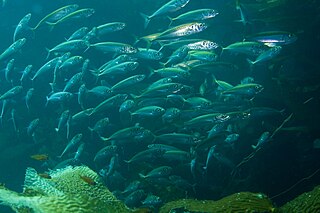
The Pacific jack mackerel, also known as the Californian jack mackerel or simply jack mackerel, is an abundant species of pelagic marine fish in the jack family, Carangidae. It is distributed along the western coast of North America, ranging from Alaska in the north to the Gulf of California in the south, inhabiting both offshore and inshore environments. The Pacific jack mackerel is a moderately large fish, growing to a maximum recorded length of 81 cm, although commonly seen below 55 cm. It is very similar in appearance to other members of its genus, Trachurus, especially T. murphyi, which was once thought to be a subspecies of T. symmetricus, and inhabits waters further south. Pacific jack mackerel travel in large schools, ranging up to 600 miles offshore and to depths of 400 m, generally moving through the upper part of the water column.
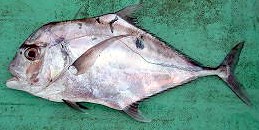
The African pompano, also known as the pennant-fish or threadfin trevally, is a widely distributed species of tropical marine fish in the jack family, Carangidae. The species is found in tropical waters worldwide, with adults often inhabiting coastlines, while juveniles are usually pelagic, floating with ocean currents. The adult Africanus pompanus is similar in appearance to the other members of the genus Alectis, with the concave shape of the head near the eyes; the clearest distinguishing feature. The juveniles are similar to other members of Alectis, having long, filamentous dorsal and anal fin tips which are thought to discourage predators. The species lives in depths less than 100 m, consuming a range of crustaceans and small fishes. The species is of minor economic importance, often taken amongst other tropical midwater fishes by hook and line, while juveniles are occasionally caught in beach seines. African pompano are also highly rated game fish, often considered one of the strongest of the jacks in larger sizes.

The African threadfish, also known as the Alexandria pompano, is a species of large marine fish in the jack family, Carangidae. The species is distributed along the coast of tropical Africa in the eastern Atlantic Ocean, extending to the Mediterranean Sea. Adults live predominantly in shallow waters shallower than 70 m deep, often forming small schools. The African threadfish is similar in appearance to the closely related and co-occurring African pompano, with the slightly concave shape of the species head profile the most definitive feature of the species. Like other members of the genus Alectis, the juveniles of the species have long trailing dorsal and anal fins. The African threadfish is of minor commercial importance, and is also considered to be a game fish.

The shrimp scad, is a species of widespread tropical marine fish of the jack family, Carangidae. The shrimp scad is widely distributed in the tropical and subtropical western Indian Ocean and areas of the eastern Pacific Ocean, ranging from South Africa in the west to Hawaii in the east, including Japan and Australia to the north and south. The species is commonly found on inshore reefs and sandy substrates. It has the common body profile of a scad, and may be difficult to differentiate from others in the genus Alepes. It is one of the larger scads, growing to 40 cm, but often is encountered at much smaller sizes. The shrimp scad often forms large schools, and is carnivorous, consuming a variety of crustaceans and small fish. It is of moderate importance to fisheries throughout its range.

The rainbow runner, also known as the rainbow yellowtail, Spanish jack and Hawaiian salmon, is a common species of pelagic marine fish of the jack family, Carangidae. The species is widespread throughout the tropical and subtropical waters of the world, inhabiting both coastal and offshore areas. The species is the only member of the genus Elagatis, which was created 15 years after its initial description, and is closely related to the amberjacks. The rainbow runner is easily distinguished by its body shape, and the brilliant colouration which gives the fish its name. It is a fast-swimming predator, taking small fish, cephalopods, and a wide variety of planktonic crustaceans. The species reaches sexual maturity around 60 cm (24 in), and spawning takes place at different times, with some populations spawning year round, while others only spawn at certain times of the year. The species is a well known game fish, taken by a variety of fishing methods, and is a well-regarded table fish. Large numbers of the species are taken as bycatch in tuna- and shark-fishing operations and marketed.

The razorbelly scad is a small species of tropical marine fish in the jack family, Carangidae. The species inhabits coastal waters in the Indo-Pacific, from Pakistan in the west to Japan and Australia in the east, often found over reefs. The razorbelly scad has a complex taxonomic history, and even recently has had its position in the genus Alepes challenged, but appears to be stable after a molecular phylogeny study supported its placement in Alepes. It is very similar to other scads in the same genus, but is readily identified by its unique teeth. Razorbelly scad are predatory fish, taking a variety of crustaceans and shrimps, and show a change in feeding intensity over the year. Reproduction and development has been extensively studied in India, where spawning occurs in a single event from January to September. The species is commonly taken in tropical fisheries, where it is marketed fresh or dried.
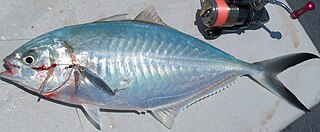
The herring scad, is a common species of tropical marine fish in the jack family Carangidae. The species inhabits the surface waters of coastal regions throughout the Indo-West Pacific region, feeding on a variety of crustaceans and small fishes. It is the largest fish of the scad genus Alepes, growing to a recorded length of 56 cm. The herring scad is identified among the genus Alepes by its more numerous and smaller scutes and the number of gill rakers on the first arch. It is of minor importance to fisheries throughout its range.
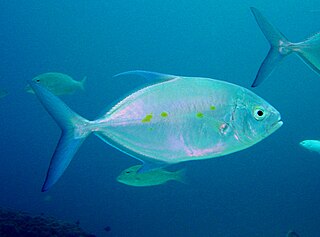
Carangoides is a genus of tropical to subtropical marine fishes in the jack family, Carangidae. They are small- to large-sized, deep-bodied fish characterised by a certain gill raker and jaw morphology, often appearing very similar to jacks in the genus Caranx. They inhabit the subtropical and tropical regions of the Indian, Pacific, and Atlantic Oceans, often occupying coastal areas, including reefs, bays, and estuaries, rarely venturing far offshore. They are all predatory fishes, taking a variety of smaller fishes, crustaceans and cephalopods as prey. The genus was first erected in 1851 by Pieter Bleeker for an unknown taxon and currently contains 20 species. Many make up significant proportions of various fisheries, although a number of ciguatera cases have been attributed to them.

The coastal trevally, also known as the onion trevally, Japanese trevally or bluefin kingfish, is a species of inshore marine fish in the jack family Carangidae. The species is distributed throughout the tropical and subtropical waters of the Indian and west Pacific Oceans, from South Africa in the west to Japan and New Caledonia in the east, reaching as far south as Australia. The species is found on deep coastal reefs, both in schools and as solitary individuals, where they prey on small midwater organisms including crustaceans, small fish and cephalopods. The species is taken as bycatch in a number of fisheries throughout its range by a number of fishing methods and is of little commercial value, but is considered to be a good table fish. A mistype in the original volume in which Eduard Rüppell named the species led to the combination Carangoides caeruleopinnatus, which has incorrectly spread through the literature.

The threadfin jack or thread pompano is a species of coastal marine fish in the jack family Carangidae. The species inhabits the tropical waters of the eastern Pacific Ocean from Baja California in the north to Ecuador and the Galapagos Islands in the south. It is a moderately large fish, growing to 60 cm (24 in) and may be recognized by its filamentous dorsal and anal fin lobes. The threadfin jack inhabits both deeper coastal waters and inshore environments, including reefs and estuaries, where it preys on minute benthic and pelagic organisms, including small fishes and crustaceans. Very little is known about the ecology and reproductive cycle in the species. The threadfin jack is of importance to fisheries throughout its distribution, caught by hook-and-line and net methods and marketed fresh and salted, and is considered a very good table fish. The species was named Carangoides dorsalis by Theodore Gill 20 years before the name Caranx otrynter was introduced, but confusion with Vomer dorsalis led to the proposal of the new name to separate the two species.

The green jack, also known as the horse jack, is an abundant species of coastal marine fish in the jack family Carangidae. The species is distributed in the eastern Pacific Ocean along the American coastline from Santa Cruz Island off California in the north to Peru in the south, as well as a number of islands including the Galapagos and recently, Hawaii. The green jack is distinguished from other similar carangid species by a number of features including gill raker and lateral line scale counts, and the presence of an adipose eyelid. It is a moderately large species, growing to at least 55 cm in length and 2.81 kg, although unconfirmed reports suggest a much larger maximum size. It lives in a wide range of continental shelf environments including estuaries, bays, reefs and offshore seamounts, living both pelagically and demersally. The green jack is a predatory species, preying on a variety of fish, crustaceans and cephalopods, as well as zooplankton. Most fish are sexually mature by the time they attain 38 cm, with spawning occurring between May and October. The species is of high importance to fisheries throughout its range, caught by pelagic trawls, a variety of netting methods and hook and line. The green jack is also of interest to anglers, taken by bait and lures, although is considered to only be fair in eating quality.

Caranx is a genus of tropical to subtropical marine fishes in the jack family Carangidae, commonly known as jacks, trevallies and kingfishes. They are moderate- to large-sized, deep-bodied fishes which are distinguished from other carangid genera by specific gill raker, fin ray and dentition characteristics. The genus is represented in the Pacific, Indian and Atlantic Oceans, inhabiting both inshore and offshore regions, ranging from estuaries and bays to deep reefs and offshore islands. All species are powerful predators, taking a variety of fish, crustaceans and cephalopods, while they in turn are prey to larger pelagic fishes and sharks. A number of fish in the genus have a reputation as powerful gamefish and are highly sought by anglers. They often make up high amounts of the catch in various fisheries, but are generally considered poor to fair table fishes.

The blue trevally, also known as the banded trevally, barred trevally, Ferdau's trevally or Forskaal's jackfish, is a common, widespread species of pelagic marine fish classified in the jack family, Carangidae. The blue trevally is distributed throughout the tropical and subtropical waters of the Indo-Pacific and central Pacific regions, ranging from South Africa in the west to Hawaii in the east. It is a moderately large fish, growing to a recorded maximum length of 70 cm, with the number of rays in the second dorsal fin and the colouring serving as diagnostic features of the species. The species inhabits waters to depths of 60 m, generally inhabiting reefs, beaches, lagoons, and areas with sandy substrates. It is a predatory fish, taking other fish, prawns, crabs, and molluscs, and very little is known of the species' reproductive biology. The blue trevally is of varying importance to fisheries throughout its range, with some regions having high catches of the fish. It is considered to be a gamefish, and is sought after for its excellent eating qualities.
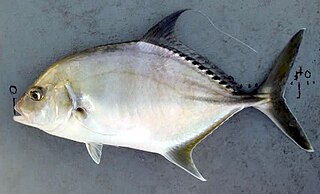
The coachwhip trevally, also known as the oblong trevally or oblique-banded trevally, is a species of inshore marine fish classified in the jack family Carangidae. The coachwhip trevally is distributed through the Indo-west Pacific region, ranging from South Africa in the west to Fiji and Japan in the east. It is a moderately large fish, growing to a known maximum length of 46 cm and can be distinguished from similar species by an array of detailed morphological features including dentition, fin ray counts and scale patterns. The coachwhip trevally inhabits coastal waters throughout its range, known to prefer estuarine waters in a number of localities. Nothing is known of its diet or reproductive biology, and is of little importance to fisheries, occasionally taken as bycatch in trawl and hook and line fisheries.

The longfin crevalle jack is a recently described species of large marine fish classified in the jack family, Carangidae. It inhabits the subtropical waters of the east Atlantic Ocean, ranging along the African coast from Mauritania south at least to Moçamedes in southern Angola, with the species historically present in the Mediterranean Sea. It is an inshore species, known to occasionally penetrate estuaries, possibly to spawn. The species is very similar to the crevalle jack, Caranx hippos, and is separated by its extended dorsal and anal fin lobes as well as more detailed anatomical features including dorsal and anal fin ray counts. The fish is known to reach 127 cm in length and 20.9 kg in weight. The longfin crevalle jack is a predatory fish, taking small fish as its main prey. Due to longstanding confusion between C. fischeri and C. hippos, the importance of each species to African fisheries is poorly understood, with a known combined catch in this region of between 2,233 and 10,054 tonnes per year in 1995–2004. Like its close relatives, the species is considered a powerful gamefish and highly sought after, although their coarse flesh makes for relatively poor quality food.

The cocinero, also known as the barred jack and striped jack, is a species of small marine fish classified in the jack family, Carangidae. The cocinero is distributed through the tropical eastern Pacific Ocean, ranging along the west American coastline from Baja California in the north to Peru in the south. It is a pelagic species, inhabiting the upper water column in both coastal and offshore oceanic waters, occasionally making its way into estuaries. The species may be identified by its colouration, having 8 or 9 incomplete dark vertical stripes on its sides, with scute and gill raker counts also diagnostic. It is small compared to most other species of Caranx, reaching a length of 37 cm in total. The cocinero is a predatory fish, taking small fishes, crustaceans, and various benthic invertebrates in shallower waters. Little is known of the species' reproductive habits. The cocinero is of moderate importance to fisheries along the west coast of South America, and the species has been used in aquaculture trials. It is taken by various netting methods and by spear, and is sold fresh, dried, and salted at market.

The torpedo scad, also known as the hardtail scad, finny scad, finletted mackerel scad or cordyla scad, is a species of moderately large marine fish classified in the jack and horse mackerel family, Carangidae. The torpedo scad is distributed throughout the tropical Indo-Pacific region, ranging from South Africa in the west to Tonga in the east, extending to Japan in the north and Australia in south. It is a schooling pelagic fish which occupies the surface layers of both inshore and offshore oceanic waters. The torpedo scad is easily identified by both its 'torpedo' shaped body and a series of detached finlets at the rear of both the dorsal and anal fins. The largest recorded individual was 80 cm long and weighed 4 kg, although it is more common at lengths less than 40 cm. It is a predatory species, taking a variety of fish, cephalopods and crustaceans by both active and filter feeding. There is a shift in diet as the species grow; however fish is the dominant prey in all size classes. Torpedo scad reach sexual maturity at 22 cm in females and 26.4 cm in males, with spawning occurring between March and July in India, where significant research into larval growth and morphometrics has been carried out.

The yellowstripe scad, also known as the yellowstripe trevally, yellow-banded trevally, smooth-tailed trevally, slender-scaled trevally and slender trevally, is a species of small inshore fish in the jack and horse mackerel family Carangidae, and the only member of the genus Selaroides. The yellowstripe trevally is distributed throughout the tropical waters of the Indo-West Pacific region, ranging from the Persian Gulf in the west to Vanuatu and New Caledonia in the east. The species is distinguished by its prominent lateral yellow band, and differs from the scads of the genus Selar in having a smaller eye and different dentition. The yellowstripe scad reaches a maximum recorded length of 22 cm, however is normally encountered at sizes less than 15 cm. Phylogenetic studies indicate the yellowstripe scad is closely related to the scads of the genus Selar, although its exact placement in the family Carangidae is less well agreed upon.

Scomberoides commersonnianus, the Talang queenfish, also known as giant dart, giant leatherskin, giant queenfish, largemouth queenfish, leatherjacket, leatherskin, and Talang leatherskin, is a species of ray-finned fish in the family Carangidae from the western Indo-Pacific. It is a large species which is important in commercial and recreational fisheries.
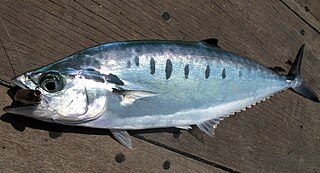
The needlescaled queenfish, also known as the slender queenfish, needleskin queenfish and slender leatherskin, is a tropical game fish in family Carangidae.






















